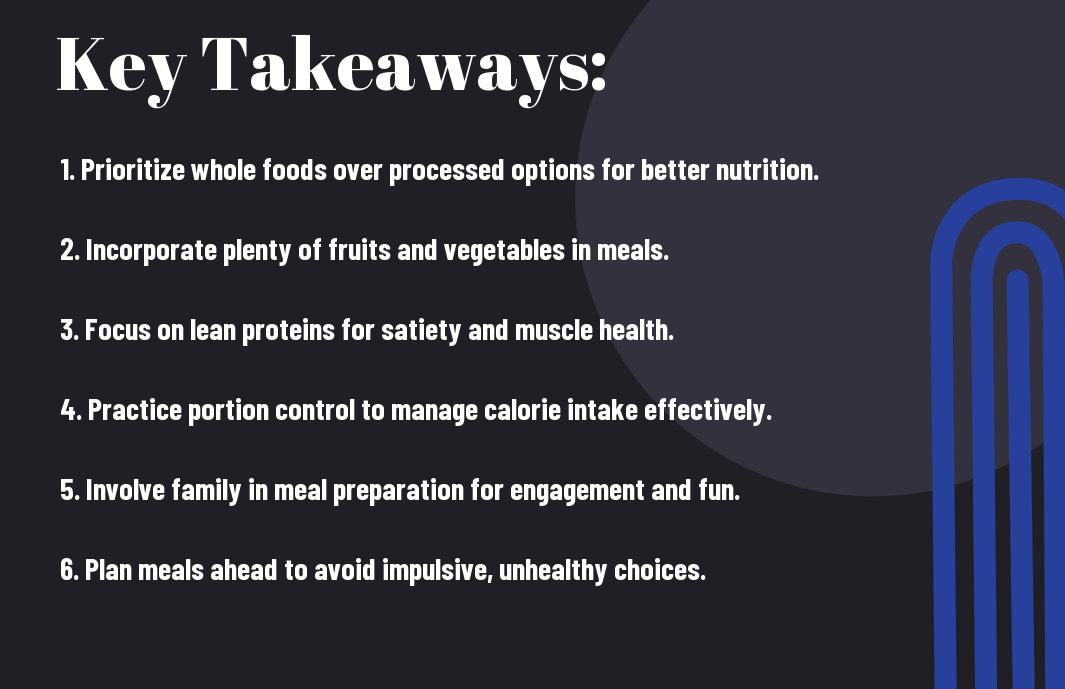Most families struggle to balance the need for nutritious meals with the desire for delicious flavors, especially when weight loss is a goal. You can create meals that foster a healthier lifestyle without sacrificing taste for you and your loved ones. This blog post will guide you through simple, wholesome recipes that are not only good for you but also appeal to everyone’s palate, making it easier to commence on your weight loss journey together.
Key Takeaways:
- Balanced Nutrition: Focus on meals that incorporate a variety of food groups, including lean proteins, whole grains, and plenty of fruits and vegetables.
- Portion Control: Be mindful of serving sizes to avoid overeating. Use smaller plates to help manage portions effectively.
- Meal Planning: Plan meals ahead of time to ensure a healthy eating schedule and reduce the temptation of unhealthy options.
- Cooking Methods: Opt for healthier cooking techniques such as baking, steaming, or grilling instead of frying.
- Family Involvement: Engage the whole family in meal preparation to encourage healthier eating habits and make cooking a fun activity.
- Smart Snacking: Choose healthy snacks, like fruits, nuts, or yogurt, to keep energy levels stable and minimize unhealthy cravings.
- Hydration: Drink plenty of water throughout the day; it helps with digestion and can reduce unnecessary snacking between meals.
Nutritional Principles for Healthy Family Meals
Your family’s meals should focus on nutrient-dense ingredients that provide crucial vitamins and minerals while promoting overall well-being. Emphasizing a variety of foods can help maintain energy levels and support weight loss goals. By understanding and applying nutritional principles, you can create balanced meals that satisfy diverse tastes and dietary needs within your family.
Balanced Macronutrients
Along with incorporating a healthy mix of carbohydrates, proteins, and fats, it’s important to consider portion sizes to ensure energy balance. Aim for meals that include lean proteins, whole grains, and healthy fats to keep your family nourished and full. This combination not only promotes sustained energy but also supports muscle maintenance while fostering weight loss.
Incorporating Whole Foods
Against the temptation to rely on processed foods, making whole foods the cornerstone of your family’s meals will provide more vital nutrients and flavor. Whole foods, such as fruits, vegetables, whole grains, nuts, and legumes, are naturally high in fiber and antioxidants, making them excellent for overall health. Their natural state means they are free from added sugars and unhealthy fats, which can hinder weight loss efforts.
Balanced meals featuring whole foods enhance your family’s nutrition while minimizing the intake of empty calories. You can easily include a rainbow of fruits and vegetables, whole grains, and lean proteins in your weekly meal plan. This approach not only ensures better nutritional content but also instills healthy eating habits in your family. Making a shift towards whole foods can lead to sustainable weight loss and improved health for everyone.


Meal Planning Strategies
If you want to streamline your family’s healthy eating habits, meal planning is key. By taking the time to outline your meals for the week, you can save time, reduce food waste, and ensure that everyone in your family is enjoying nutritious options. Having a plan can also help you stick to your weight loss goals by keeping you mindful of what you eat and preventing last-minute unhealthy choices.
Creating a Weekly Menu
Meal planning can simplify your week and make healthy eating a breeze. Start by selecting a variety of proteins, vegetables, and whole grains to feature in your meals. Create a balanced menu that includes breakfast, lunch, dinner, and snacks, ensuring each meal contains nutrient-dense ingredients. This will not only help you keep track of your meals but also make grocery shopping more efficient.
Shopping for Healthy Ingredients
By knowing exactly what you need, you can shop smarter and avoid impulse buys. Planning your meals ahead allows you to create a comprehensive shopping list, ensuring your cart is filled with healthy options. This will help you stock your kitchen with fresh fruits, vegetables, whole grains, and lean proteins that promote weight loss.
It’s helpful to shop the perimeter of the store, where fresh produce, meats, and dairy are usually located. Look for seasonal fruits and vegetables to save money and enhance flavor. Don’t forget to check labels on packaged items for added sugars and sodium. Prioritizing fresh, unprocessed foods will help you stay on track with your weight loss goals while satisfying your family’s taste buds.
Cooking Techniques for Weight Loss
Once again, the way you prepare your meals can impact your weight loss journey. Opt for techniques that minimize added fats and calories. Healthy meals can be simple to create; check out this 30 Days of Healthy Dinner Recipes for Weight Loss for inspiration that keeps your family satisfied while supporting your goals.
Healthy Cooking Methods
Any time you plan a meal, consider using healthy cooking methods such as grilling, steaming, baking, or sautéing. These techniques enhance the natural flavors of your ingredients while keeping calorie counts low, enabling you to serve meals that are both nutritious and delicious.
Portion Control Tips
Before venturing into your meal, be mindful about portion sizes. This act can prevent overeating and help you stay on track with your weight loss. Here are some tips:
- Use smaller plates to create the illusion of a fuller plate.
- Measure out servings instead of eating directly from the package.
- Fill half of your plate with vegetables and fruits.
- Limit high-calorie foods by preparing them in smaller amounts.
- After eating, wait 10-15 minutes to see if you’re still hungry.
After adjusting your portions, you’ll likely feel more satisfied while still achieving your weight loss goals.
For instance, fine-tuning your portions is an effective strategy for controlling calorie intake. Ideas include:
- Utilizing measuring cups or a food scale when preparing meals.
- Asking family members to serve themselves instead of dishing out portions.
- Keeping snacks in single servings rather than large containers.
- After trying these practices, you may discover that you can enjoy everything in moderation while still losing weight.
Family-Friendly Recipes
All families can enjoy delicious meals without sacrificing health or flavor. Explore A month of 500-calorie dinners for families on a budget that caters to all tastes while promoting weight loss. These recipes keep everyone satisfied while fitting into your family’s nutritional goals.
Breakfast Ideas
At the start of your day, fuel your family with balanced breakfast options. Incorporate wholesome ingredients like oats, fruits, and low-fat proteins to create energizing meals that kick off the morning right. Simple ideas like smoothie bowls or veggie omelets can keep everyone nourished and ready for the day ahead.
Lunch and Dinner Options
Around mealtime, it’s important to offer meals that are both filling and nutritious. Focus on lean proteins, whole grains, and plenty of vegetables to create satisfying dishes that support weight loss. Consider versatile ingredients like quinoa, chicken, and seasonal produce for a variety of flavors and textures.
Ideas for lunch and dinner can include colorful stir-fries, hearty soups, or simple salads that bring the family together while promoting health. You can easily swap ingredients or try new spices to keep things interesting. With a little creativity and planning, you can prepare meals that everyone will love, making healthy eating enjoyable for your whole family.

Involving the Family in Meal Preparation
Unlike traditional meal prep strategies, involving your family in the cooking process can enhance enjoyment and foster healthier eating habits. When everyone pitches in, it encourages a sense of teamwork and commitment to healthier choices. You can assign tasks based on the age and skill level of each family member, making the experience both educational and fun. This will not only streamline your meal preparations but also create lasting memories around the dining table.
Cooking Together
Above all, cooking together can transform mealtime into a bonding experience. As you and your family chop, mix, and season your dishes, you’ll forge connections while learning about the food you eat. It’s a fantastic way to explore new recipes, making healthy eating an adventure that everyone can contribute to.
Teaching Healthy Habits
Around the kitchen, you have a golden opportunity to instill healthy habits in your children. By involving them in meal preparation, you can teach valuable lessons about nutrition, portion sizes, and the importance of whole foods. This hands-on experience empowers them to make better food choices in the future.
Another effective way to teach healthy habits is to discuss the benefits of various ingredients while cooking. For example, as you chop vegetables, explain their nutritional value and how they support a balanced diet. Sharing stories about how certain foods keep you energized can inspire your children to appreciate healthy meals more, setting the foundation for lifelong wellness.

Overcoming Challenges
Many families face hurdles when trying to maintain healthy meal plans for weight loss. From busy schedules to differing tastes, navigating these challenges requires flexibility and creativity. If you’re wondering How do you plan meals to lose weight with a family/partner?, consider involving everyone in the meal prep process to foster a team effort and share accountability.
Picky Eaters Solutions
Behind every picky eater is the challenge of catering to diverse tastes. You can overcome this by introducing new foods gradually and presenting them in fun ways, such as colorful plates or themed meal nights. Encourage your family to take part in taste-testing sessions to make trying new foods exciting.
Maintaining Motivation
Above all, staying motivated during your weight loss journey can be difficult, especially when family dynamics are involved. Setting collective goals with your family can help create a sense of unity and shared purpose, making it easier to stay on track.
Another strategy to maintain motivation is to celebrate small wins together. Create a rewards system for reaching milestones, whether it’s a family outing or a special treat. Keeping communication open about everyone’s progress and challenges encourages a supportive environment, making weight loss a shared experience rather than an individual struggle.
Final Words
Drawing together the principles of healthy family meals not only supports your weight loss goals but also strengthens family bonds. By prioritizing whole ingredients and balanced portions, you empower yourself and your loved ones to make better food choices. Engage your family in meal prep and explore new recipes together to keep the process enjoyable. With a little planning and creativity, you can create nutritious meals that everyone will love, making weight loss a positive journey for you and your family.
FAQ
Q: What are some examples of healthy meals for families looking to lose weight?
A: Healthy family meals can include options like grilled chicken with quinoa and steamed broccoli, vegetable stir-fry with tofu, baked salmon with a side of sweet potatoes and green beans, or whole wheat pasta with a variety of vegetables and a light tomato sauce. Incorporating lots of fresh fruits and vegetables, lean proteins, and whole grains can help keep meals nutritious and satisfying.
Q: How can I make healthier versions of my family’s favorite recipes?
A: You can make healthier versions of favorite recipes by substituting high-calorie ingredients with lighter alternatives. For example, use Greek yogurt instead of sour cream, opt for whole grain bread instead of white bread, and replace frying with baking or grilling. Additionally, reducing portion sizes and incorporating more vegetables can enhance the meal’s nutritional value while keeping the flavors your family loves.
Q: How can I encourage my family to eat healthier meals?
A: Encouraging healthier eating habits can start with involving your family in meal planning and preparation. Discuss the benefits of healthy foods, make it a fun experience by trying new recipes, and set a good example by seeking nutritious options for yourself. Also, ensure that healthy snacks are available and create a pleasant mealtime atmosphere to promote enjoyable and mindful eating.
Q: What are some tips for meal prepping for weight loss?
A: Meal prepping can be effective for weight loss. Start by selecting recipes for the week and creating a shopping list. Set aside some time during the weekend to cook large batches of meals, divide them into portions, and store them in the fridge or freezer. Use clear containers to help you see what you have on hand, and label meals with dates to ensure freshness. This can save time during the week and keep you focused on nutritious options.
Q: What role do portion sizes play in weight loss for families?
A: Portion sizes are important in weight loss as they can help control calorie intake. Educate your family about appropriate serving sizes and encourage them to listen to their hunger cues. Using smaller plates and bowls can create the illusion of a fuller serving, while also encouraging slower eating, which helps with feeling satisfied. Balancing portions of proteins, carbohydrates, and fats in meals is key to staying on track.
Q: How can I incorporate more vegetables into family meals?
A: Incorporating more vegetables can be done by adding them to every meal. Include them in smoothies, soups, salads, or stir-fries. Get creative by trying different cooking methods like roasting, which enhances flavor, or blending them into sauces. Involve your family by allowing them to choose which vegetables they’d like to try or growing a small vegetable garden to spark interest in eating more greens.
Q: Can healthy meals still taste good while being low in calories?
A: Absolutely, healthy meals can be very flavorful. Using herbs, spices, and citrus can enhance taste without adding excessive calories. Experiment with different cooking techniques, such as grilling, roasting, and steaming, to maintain food’s natural flavors. Healthy fats like avocado or olive oil in moderation can add richness and make meals satisfying. With the right ingredients and preparation, health-conscious meals can be delicious and enjoyable for the whole family.




